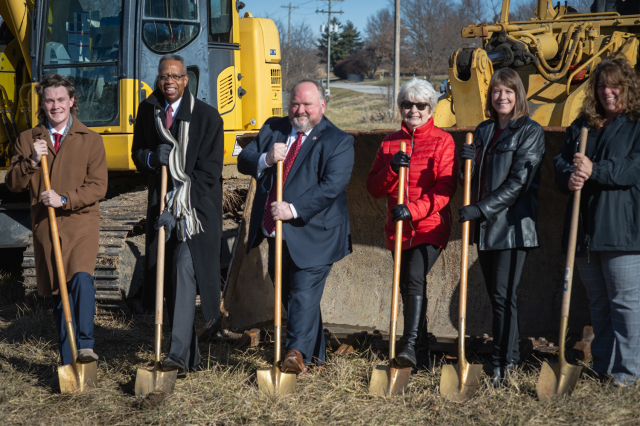Federal Partners Celebrate Construction of Centralized Wastewater System and Treatment Facility with City of Camden Point, Missouri
U.S. Representative Sam Graves (MO-6), EPA, USDA, and HUD join recognition ceremony and groundbreaking event with Mayor Gloria Boyer
LENEXA, KAN. (DEC. 18, 2023) – Today, federal partners joined Mayor Gloria Boyer of the City of Camden Point, Missouri, to celebrate the construction of a centralized, sanitary sewer collection system and wastewater treatment facility that will improve the health and well-being of the city’s residents.
The day’s events included a funding recognition ceremony and a groundbreaking event at the city’s future wastewater treatment plant site. Speakers included U.S. Representative Sam Graves (MO-6), U.S. Environmental Protection Agency (EPA) Region 7 Water Division Director Dana Skelley, U.S. Department of Agriculture (USDA) Rural Development’s Missouri State Office Director Kyle Wilkens, and U.S. Department of Housing and Urban Development (HUD) Region 7 Administrator Ulysses “Deke” Clayborn.
"I would like to thank Congressman Graves, USDA, EPA, the Community Development Block Grants program, and many others who have worked tirelessly to make this project happen,” Boyer said. “A special recognition to the past mayor, Mark Wagoner, as well as the City Council who have worked so diligently on this project. And lastly, a special thanks to the residents of Camden Point for their understanding and patience."
The sewer and wastewater treatment project is estimated to cost over $8 million, with funding supplied through EPA, USDA, HUD, revenue bonds, and city funds.
In October, EPA awarded $3,361,707 to the City of Camden Point through the EPA Community Grants Program. Congress appropriates resources for specifically named community water infrastructure projects through this program.
"This is a big day for the City of Camden Point,” Graves said. “While I'm proud to have secured a portion of the funding that's going to be used to build a new sewer system through the congressional appropriations process, I'm also incredibly grateful for the work of Mayor Boyer and so many Camden Point leaders over the years who have worked to make this project a reality. This new infrastructure is critical to supporting the growing community of Camden Point well into the future."
This grant will be used to construct a centralized sanitary sewer system and wastewater treatment facility. It will also be used to decommission septic systems currently used throughout the city, many of which are failing to function as intended.
The sewer system will connect to each of more than 200 households at no cost to the residents and will utilize over 56,000 feet of sewer pipes.
“EPA is thrilled to be celebrating the construction of a wastewater system and treatment facility with Camden Point,” said EPA Region 7 Administrator Meg McCollister. “Clean water is essential, and this project is a powerful example of what can be achieved when federal, state, and local leaders work together to bring resources to communities with the greatest need.”
USDA has provided $4,903,400 toward the project, including two Rural Development Grants totaling $2,371,400 and a Rural Development Loan of $2,532,000.
“Today's groundbreaking is a remarkable example of the partnership between concerned citizens, elected officials, and dedicated government agencies to achieve an essential need for Camden Point," Wilkens said. "As a result, the folks in Camden Point will have a state-of-the-art wastewater system.”
HUD provided $500,000 toward the project through a Community Development Block Grant.
“In 2022, HUD’s Community Development Block Grant program assisted over 39,000 American households through new public improvements, like the wastewater facility here in Camden Point,” Clayborn said. “I am truly impressed by the transformative power of federal agencies like EPA, HUD, and USDA when working together with our state and local partners to modernize and make our nation’s critical infrastructure more resilient.”
The project is expected to last approximately three years, with an anticipated operational date in late 2026.
# # #
Learn more about EPA Region 7
View all Region 7 news releases
Connect with EPA Region 7 on Facebook
Follow us on Twitter: @EPARegion7

